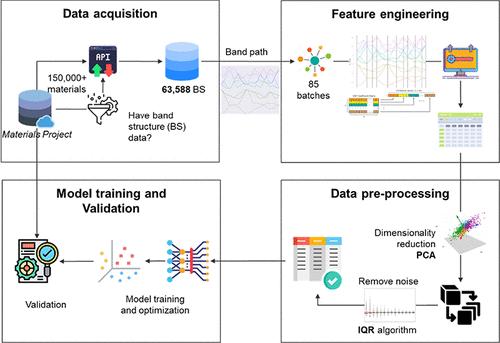当前位置:
X-MOL 学术
›
J. Chem. Inf. Model.
›
论文详情
Our official English website, www.x-mol.net, welcomes your
feedback! (Note: you will need to create a separate account there.)
Machine-Learning-Assisted Materials Discovery from Electronic Band Structure
Journal of Chemical Information and Modeling ( IF 5.6 ) Pub Date : 2024-11-03 , DOI: 10.1021/acs.jcim.4c01329 Prashant Sinha, Ablokit Joshi, Rik Dey, Shikhar Misra
Journal of Chemical Information and Modeling ( IF 5.6 ) Pub Date : 2024-11-03 , DOI: 10.1021/acs.jcim.4c01329 Prashant Sinha, Ablokit Joshi, Rik Dey, Shikhar Misra

|
Traditional methods of materials discovery, often relying on intuition and trial-and-error experimentation, are time-consuming and limited in their ability to explore the vast design space effectively. The emergence of machine learning (ML) as a powerful tool for pattern recognition has opened exciting opportunities to revolutionize materials discovery. This work explores the application of ML techniques to assist in the discovery of materials using band structure data. The electronic band structure, which describes the energy levels of electrons in a material, holds vital information regarding its electronic and optical properties. The band structure data of 63,588 materials, including metals and insulators, have been retrieved from the Materials Project database. The data were grouped into 85 batches based on the band path in the first Brillouin zone. Three ML clustering algorithms were trained on the band structure data after performing feature selection and engineering, followed by noise reduction. The models were validated by comparing the materials’ properties in a cluster.
中文翻译:

从电子能带结构中发现机器学习辅助材料
传统的材料发现方法通常依赖于直觉和试错实验,非常耗时,并且无法有效探索广阔的设计空间。机器学习 (ML) 作为一种强大的模式识别工具的出现,为彻底改变材料发现带来了令人兴奋的机会。这项工作探讨了 ML 技术在利用带状结构数据协助发现材料方面的应用。电子能带结构描述了材料中电子的能级,包含有关其电子和光学特性的重要信息。已从 Materials Project 数据库中检索了 63,588 种材料(包括金属和绝缘体)的能带结构数据。根据第一个布里渊区的频带路径将数据分为 85 个批次。在执行特征选择和工程后,在频带结构数据上训练了三种 ML 聚类算法,然后进行了降噪。通过比较集群中的材料特性来验证模型。
更新日期:2024-11-03
中文翻译:

从电子能带结构中发现机器学习辅助材料
传统的材料发现方法通常依赖于直觉和试错实验,非常耗时,并且无法有效探索广阔的设计空间。机器学习 (ML) 作为一种强大的模式识别工具的出现,为彻底改变材料发现带来了令人兴奋的机会。这项工作探讨了 ML 技术在利用带状结构数据协助发现材料方面的应用。电子能带结构描述了材料中电子的能级,包含有关其电子和光学特性的重要信息。已从 Materials Project 数据库中检索了 63,588 种材料(包括金属和绝缘体)的能带结构数据。根据第一个布里渊区的频带路径将数据分为 85 个批次。在执行特征选择和工程后,在频带结构数据上训练了三种 ML 聚类算法,然后进行了降噪。通过比较集群中的材料特性来验证模型。

































 京公网安备 11010802027423号
京公网安备 11010802027423号